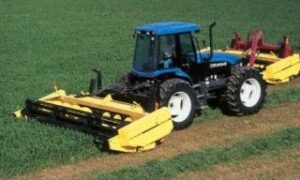Description
Front-wheel-assist tractors use a mechanical drive to the front wheels as well as the rear wheels. These tractors have become very popular in all horsepower ranges because they provide increased traction (pulling/pushing capacity) when soil conditions are not ideal. Front wheels on these tractors are larger than front wheels on two-wheel-drive tractors but smaller than the rear-drive wheels. Front-wheel-assist tractors are an extension of the rear-wheel drive tractors, but many models have more advanced controls over all phases of tractor operation. Horsepower selections from 30 to over 250 are available. In the higher horsepower range, dual tires are available for front wheels as well as duals or triples for the rear wheels. Transmissions can be standard or shift-on-the-go with up to 20 forward gears and several reverse gears. Some models automatically select optimum gear and engine speed for desired travel speed based on load and optimum engine efficiency. Tractors are equipped with a rear-mounted, three-point hitch and a trailing drawbar. The three-point hitch is instrumented to control load, depth, and weight transfer for optimum traction. A few models also have a front mounted three-point hitch. Tractors are normally equipped with climate-controlled cabs because of the many electronic devices used to control accessories. Global position systems (GPS/GIS) are available to control variable-rate applicators such as fertilizers, sprayers, and planters. Some models use GPS to assist in steering. Tractors without cabs are equipped with roll-over protection structures. Hydraulic systems provide power for steering, brakes, lift capacity for the three-point hitch, and from one to five outlets for remote cylinders and/or motors. The hydraulic remote outlets are programmable for various functions. Power-take-off shafts operate at 540 or 1,000 rpm depending on tractor size. On some models the three-point-hitch-raise/lower switch can be programmed to control several other functions. This is helpful when turning.
Application
Front-wheel-assist tractors have specially designed front axles for tight turns. They are maneuverable and create little soil disturbance when turning. Dual and triple wheel combinations are used on many of the higher horsepower tractors to provide enough traction to pull large implements and reduce soil compaction. Multiple tasks are possible in one tractor operation to accomplish complex revegetation projects. Matching tire size to the tractor manufacturer’s specifications is very important to prevent undue tire or power train wear. Consideration must be given to addition of wheel weights and/or liquid in the tires for increased traction. Weights on the front of the tractor are still necessary. The front-to-rear weight ratio is different than for rear-wheel drive tractors; therefore, manufacturer’s recommendations on the addition of extra weight should be followed for optimum tractor performance. If not in balance, a very noticeable vibration called “power hop” occurs under stressful pulling conditions. Reduced traction occurs during power hop and the resulting vibration is detrimental to the tractor. Soil compaction can be a problem with these heavy tractors in high moisture soil conditions. Sites with logs, stumps, and thorns can damage the tires. Tractor shielding and tire protection are necessary when operating on debris-littered wildland (see Tractor Modifications for Rangeland Use).
Vendors
References / Additional Information
See also the description and explanation of Tractors and Torque.


